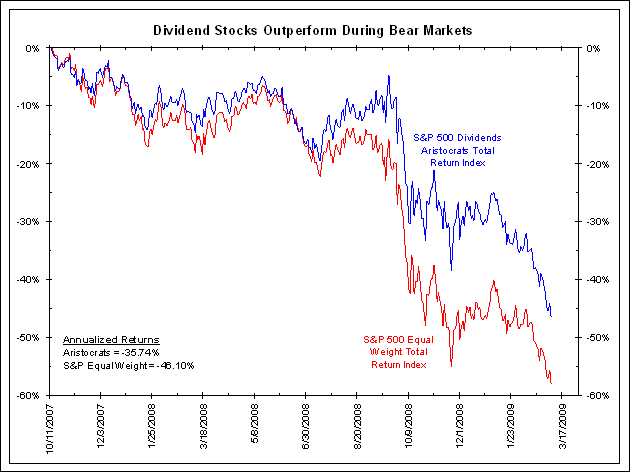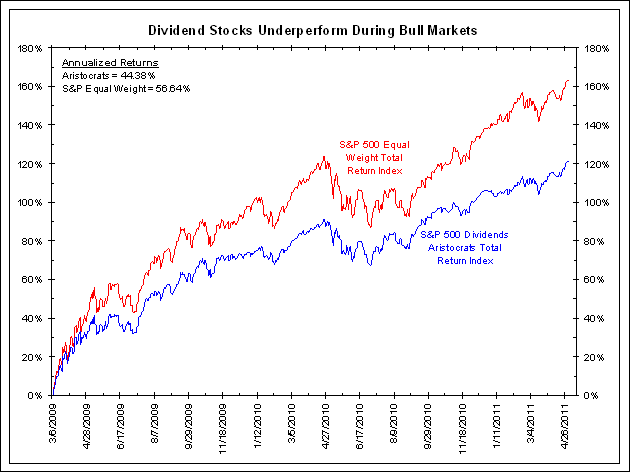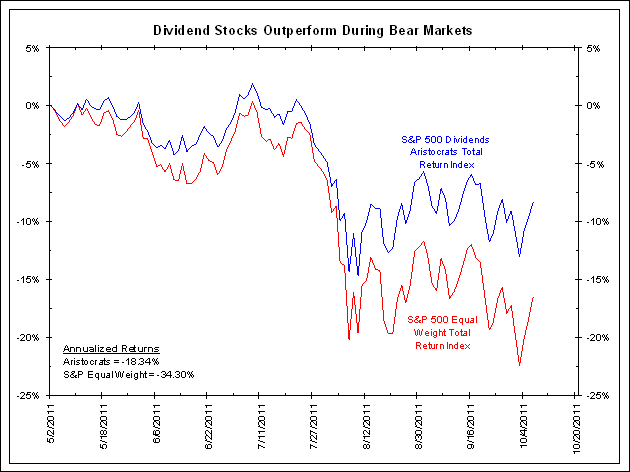The biggest bond gains in almost a
decade have pushed returns on Treasuries above stocks over the
past 30 years, the first time that’s happened since before the
Civil War.
Fixed-income investments advanced 6.25 percent this year, almost triple the 2.18 percent rise in the Standard & Poor’s 500 Index through last week, according to Bank of America Merrill Lynch indexes. Debt markets are on track to return 7.63 percent this year, the most since 2002, the data show. Long-term government bonds have gained 11.5 percent a year on average over the past three decades, beating the 10.8 percent increase in the S&P 500, said Jim Bianco, president of Bianco Research in Chicago.
The combination of a core U.S. inflation rate that has averaged 1.5 percent this year, the Federal Reserve’s decision to keep its target interest rate for overnight loans between banks near zero through 2013, slower economic growth and the highest savings rate since the global credit crisis have made bonds the best assets to own this year. Not only have bonds knocked stocks from their perch as the dominant long-term investment, their returns proved everyone from Bill Gross to Meredith Whitney and Nassim Nicholas Taleb wrong.
“The generation-long outperformance of bonds over stocks has been the biggest investment theme that everyone has just gotten plain wrong,” Bianco said in an Oct. 26 telephone interview. “It’s such an ingrained idea in everyone’s head that such low yields should be shunned in favor of stocks, that no one wants to disrupt the idea, never mind the fact that it has been off.”
U.S. government debt is up 7.23 percent this year, according to Bank of America Merrill Lynch’s U.S Master Treasury index. Municipal securities have returned 8.17 percent, corporate notes have gained 6.24 percent and mortgage bonds have risen 5.11 percent. The S&P GSCI index of 24 commodities has returned 0.25 percent.
The yield dropped 11 basis points today to 2.21 percent at 10:21 a.m. in New York.
The shift to debt wasn’t anticipated by Gross, who as co- chief investment officer of Newport Beach, California-based Pacific Investment Management Co. runs the world’s biggest bond fund. His $242 billion Total Return Fund, which unloaded Treasuries in February before the rally, has gained 2.55 percent this year, putting it in the bottom 18th percentile of similar funds, according to data compiled by Bloomberg.
Whitney, a banking analyst who correctly turned bearish on Citigroup Inc. in 2007, predicted in December “hundreds of billions of dollars” of municipal defaults that haven’t happened. Taleb, author of “The Black Swan” and a principal at Universa Investments LP, said at a conference in Moscow on Feb. 3 that the “first thing” investors should avoid is Treasuries.
What the bears failed to anticipate was that Americans would continue to pare debt and boost savings. Much of that money found its way into the fixed-income markets as banks and investors sought high-quality debt as unemployment held at or above 9 percent every month except for two since May 2009, Europe’s fiscal crisis threatened to push the global economy back into recession and stock markets fell.
“It’s hard to envision a scenario where we see significantly better than two percent growth, with increased fiscal austerity and headwinds from the leverage bubble and persistent unemployment,” said Rick Rieder, who oversees $620 billion as chief investment officer of fundamental fixed income at New York-based Blackrock Inc. The firm is the world’s largest money manager, investing $3.45 trillion.
Banks, still trying to rebuild their balance sheets after taking more than $2 trillion in writedowns and losses since the start of 2007, have boosted holdings of Treasuries and government-backed mortgage securities to $1.68 trillion from $1.62 trillion in December, according to the Fed. Foreign investors increased their stake in Treasuries to $4.57 trillion in August from $4.44 trillion at the end of 2010, according to the latest Treasury Department data.
The bond market posted its first 30-year gain over the stock market in more than a century during the period ended Sept. 30. The last time was in 1861, leading into the Civil War, when the U.S was moving from farm to factory, according to Siegel, author of the 1994 book “Stocks for the Long Run,” in a telephone interview Oct. 25.
Gross eliminated Treasuries from the Total Return Fund in February and owned derivative bets against the debt in March. He moved 16 percent of its assets into U.S. government securities as of September, saying earlier this month in a note to clients that he misjudged the extent of the economic slowdown and called his performance this year “a stinker.”
Local government bonds are set for the biggest gains since 2009 as defaults fell last quarter. Cities and states are reducing expenses instead of forgoing payments on debt even as they confront fiscal strains in the wake of falling revenue.
Money has poured into Treasuries even as U.S. budget deficits totaled $1.4 trillion in fiscal 2009 ended Sept. 30, $1.29 trillion in 2010 and $1.3 trillion in 2011.
Rising deficits and debt led Taleb, the distinguished professor of risk engineering at New York University, to tell investors in February that the “first thing” they should do is avoid Treasuries, and the second shun the dollar. At the same conference a year earlier he said “every single human being” should bet against U.S. government debt.
Concerns about inflation have also abated. Consumer prices, excluding food and energy, rose 0.05 percent in September, the smallest gain since October 2010, the Labor Department said Oct. 19 in Washington. Yields on bonds that protect investors from rising consumer prices suggest the fixed-income market anticipates inflation will average to 2.15 percent over the next decade, down from expectations of 2.67 percent in April.
“The Fed is legally obligated to do everything in their power to keep unemployment low, and they have and will continue to do so,” said Chris Low, chief economist at FTN Financial in New York. “As long as inflation isn’t a concern the Fed is going to keep firing until something happens,” Low said in a telephone interview Oct. 21.
Low was one of three economists in a Bloomberg survey of 72 forecasters in January to predict that 10-year Treasury yields would trade below 3 percent this quarter.
Vice Chairman Janet Yellen said Oct. 21 that a third round of large-scale securities purchases might become warranted. Last month, policy makers said they would replace $400 billion of short-term debt with longer-term Treasuries in an effort to contain borrowing costs.
“The Fed’s hope is that by pushing down Treasury rates, all other rates will follow,” Jay Mueller, who manages about $3 billion of bonds at Wells Fargo Capital Management in Milwaukee, said in a telephone interview Oct. 26.
“As a portfolio manager who has been in the business 30 years, it’s hard to come to terms where interest rates are, but you have to come to terms with it,” Mark MacQueen, who oversees bond investments at Austin, Texas-based Sage Advisory Services Ltd., which manages $9.5 billion, said in an Oct. 26 telephone interview. “And when you look at what stocks have done this decade it becomes much easier.”
Fixed-income investments advanced 6.25 percent this year, almost triple the 2.18 percent rise in the Standard & Poor’s 500 Index through last week, according to Bank of America Merrill Lynch indexes. Debt markets are on track to return 7.63 percent this year, the most since 2002, the data show. Long-term government bonds have gained 11.5 percent a year on average over the past three decades, beating the 10.8 percent increase in the S&P 500, said Jim Bianco, president of Bianco Research in Chicago.
The combination of a core U.S. inflation rate that has averaged 1.5 percent this year, the Federal Reserve’s decision to keep its target interest rate for overnight loans between banks near zero through 2013, slower economic growth and the highest savings rate since the global credit crisis have made bonds the best assets to own this year. Not only have bonds knocked stocks from their perch as the dominant long-term investment, their returns proved everyone from Bill Gross to Meredith Whitney and Nassim Nicholas Taleb wrong.
“The generation-long outperformance of bonds over stocks has been the biggest investment theme that everyone has just gotten plain wrong,” Bianco said in an Oct. 26 telephone interview. “It’s such an ingrained idea in everyone’s head that such low yields should be shunned in favor of stocks, that no one wants to disrupt the idea, never mind the fact that it has been off.”
Market Returns
Stocks had risen more than bonds over every 30-year period from 1861, according to Jeremy Siegel, a finance professor at the University of Pennsylvania’s Wharton School in Philadelphia, until the period ending in Sept 30.U.S. government debt is up 7.23 percent this year, according to Bank of America Merrill Lynch’s U.S Master Treasury index. Municipal securities have returned 8.17 percent, corporate notes have gained 6.24 percent and mortgage bonds have risen 5.11 percent. The S&P GSCI index of 24 commodities has returned 0.25 percent.
Falling Yields
While 10-year Treasury yields rose 10 basis points, or 0.10 percentage point, last week to 2.32 percent, they are down from this year’s high of 3.77 percent on Feb. 9. The price of the benchmark 2.125 percent note due August 2021 fell 27/32, or $8.44 per $1,000 face value, in the five days ended Oct. 28 to 98 10/32, according to Bloomberg Bond Trader data.The yield dropped 11 basis points today to 2.21 percent at 10:21 a.m. in New York.
The shift to debt wasn’t anticipated by Gross, who as co- chief investment officer of Newport Beach, California-based Pacific Investment Management Co. runs the world’s biggest bond fund. His $242 billion Total Return Fund, which unloaded Treasuries in February before the rally, has gained 2.55 percent this year, putting it in the bottom 18th percentile of similar funds, according to data compiled by Bloomberg.
Whitney, a banking analyst who correctly turned bearish on Citigroup Inc. in 2007, predicted in December “hundreds of billions of dollars” of municipal defaults that haven’t happened. Taleb, author of “The Black Swan” and a principal at Universa Investments LP, said at a conference in Moscow on Feb. 3 that the “first thing” investors should avoid is Treasuries.
What Went Wrong
The reluctance to purchase debt continues. Leon Cooperman, chairman of $3.5 billion hedge fund Omega Advisors Inc., said in a presentation at the Value Investing Congress in New York on Oct. 18 that he “wouldn’t be caught dead owning a U.S. government bond.”What the bears failed to anticipate was that Americans would continue to pare debt and boost savings. Much of that money found its way into the fixed-income markets as banks and investors sought high-quality debt as unemployment held at or above 9 percent every month except for two since May 2009, Europe’s fiscal crisis threatened to push the global economy back into recession and stock markets fell.
“It’s hard to envision a scenario where we see significantly better than two percent growth, with increased fiscal austerity and headwinds from the leverage bubble and persistent unemployment,” said Rick Rieder, who oversees $620 billion as chief investment officer of fundamental fixed income at New York-based Blackrock Inc. The firm is the world’s largest money manager, investing $3.45 trillion.
Higher Savings
The U.S. savings rate has tripled to 3.6 percent since 2005 and has averaged 5.1 percent since the depth of the financial crisis in December 2008, compared with 3.1 percent for the previous 10 years, according to government data. Debt mutual funds have attracted $789.4 billion since 2008, compared with a $341 billion drop in equity funds, according to data compiled by Bloomberg and the Washington-based Investment Company Institute.Banks, still trying to rebuild their balance sheets after taking more than $2 trillion in writedowns and losses since the start of 2007, have boosted holdings of Treasuries and government-backed mortgage securities to $1.68 trillion from $1.62 trillion in December, according to the Fed. Foreign investors increased their stake in Treasuries to $4.57 trillion in August from $4.44 trillion at the end of 2010, according to the latest Treasury Department data.
The bond market posted its first 30-year gain over the stock market in more than a century during the period ended Sept. 30. The last time was in 1861, leading into the Civil War, when the U.S was moving from farm to factory, according to Siegel, author of the 1994 book “Stocks for the Long Run,” in a telephone interview Oct. 25.
‘Millennium Event’
“The rally in bonds is a once in a millennium event, but it’s absolutely mathematically impossible for bonds to get any kind of returns like this going forward whereas stock returns can repeat themselves, and are likely to outperform,” he said. “If you missed the rally in bonds, well, then that’s it.”Gross eliminated Treasuries from the Total Return Fund in February and owned derivative bets against the debt in March. He moved 16 percent of its assets into U.S. government securities as of September, saying earlier this month in a note to clients that he misjudged the extent of the economic slowdown and called his performance this year “a stinker.”
Local government bonds are set for the biggest gains since 2009 as defaults fell last quarter. Cities and states are reducing expenses instead of forgoing payments on debt even as they confront fiscal strains in the wake of falling revenue.
One Miss
Whitney said on the CBS’s “60 Minutes” in December that there would be “hundreds of billions of dollars” of municipal defaults this year. Brighton, Alabama, a city of 2,945 near Birmingham, was the only U.S. municipality to miss a general- obligation debt payment in 2011. Defaults are about 25 percent of 2010’s $4.3 billion tally, according to Bank of America Corp.Money has poured into Treasuries even as U.S. budget deficits totaled $1.4 trillion in fiscal 2009 ended Sept. 30, $1.29 trillion in 2010 and $1.3 trillion in 2011.
Rising deficits and debt led Taleb, the distinguished professor of risk engineering at New York University, to tell investors in February that the “first thing” they should do is avoid Treasuries, and the second shun the dollar. At the same conference a year earlier he said “every single human being” should bet against U.S. government debt.
Tame Inflation
Since February Treasuries have rallied 7.99 percent and the currency has gained 3.2 percent, beating 14 of its 16 most actively traded peers, according to Bank of America Merrill Lynch indexes and data compiled by Bloomberg.Concerns about inflation have also abated. Consumer prices, excluding food and energy, rose 0.05 percent in September, the smallest gain since October 2010, the Labor Department said Oct. 19 in Washington. Yields on bonds that protect investors from rising consumer prices suggest the fixed-income market anticipates inflation will average to 2.15 percent over the next decade, down from expectations of 2.67 percent in April.
“The Fed is legally obligated to do everything in their power to keep unemployment low, and they have and will continue to do so,” said Chris Low, chief economist at FTN Financial in New York. “As long as inflation isn’t a concern the Fed is going to keep firing until something happens,” Low said in a telephone interview Oct. 21.
Low was one of three economists in a Bloomberg survey of 72 forecasters in January to predict that 10-year Treasury yields would trade below 3 percent this quarter.
Fed Signals
Fed policy makers, who meet this week, have signaled that they are considering more measures to boost the economy, after holding the target rate for overnight loans between banks at zero to 0.25 percent since December 2008 and expanding its balance sheet to a record $2.88 trillion.Vice Chairman Janet Yellen said Oct. 21 that a third round of large-scale securities purchases might become warranted. Last month, policy makers said they would replace $400 billion of short-term debt with longer-term Treasuries in an effort to contain borrowing costs.
“The Fed’s hope is that by pushing down Treasury rates, all other rates will follow,” Jay Mueller, who manages about $3 billion of bonds at Wells Fargo Capital Management in Milwaukee, said in a telephone interview Oct. 26.
“As a portfolio manager who has been in the business 30 years, it’s hard to come to terms where interest rates are, but you have to come to terms with it,” Mark MacQueen, who oversees bond investments at Austin, Texas-based Sage Advisory Services Ltd., which manages $9.5 billion, said in an Oct. 26 telephone interview. “And when you look at what stocks have done this decade it becomes much easier.”








